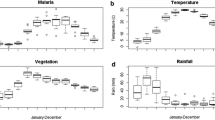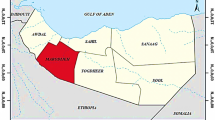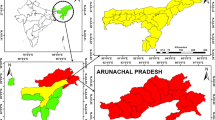Abstract
Malaria is a major public health problem in tropical and subtropical countries of the World. During the year 1999, Visakhapatnam district of Andhra Pradesh, India experienced a major epidemic of malaria, and nearly 41,805 cases were reported. Hence, a retrospective malaria surveillance study was conducted from 2001 to 2016 and reported nearly a total of 149,317 malaria cases during the study period. Of which, Plasmodium vivax contributes 32%, and Plasmodium falciparum contributes 68% of the total cases. Malaria cases follow a strong seasonal variation and 70% of cases are reported during the monsoon periods. In the present study, we exploited multi step polynomial regression and seasonal autoregressive integrated moving average (SARIMA) models to forecast the malaria cases in the study area. The polynomial model predicted malaria cases with high predictive power and found that malaria cases at lag one, and population played a vital role in malaria transmission. Similarly, mean temperature, rainfall and Normalized Difference Vegetation Index build a significant impact on malaria cases. The best fit model was SARIMA (1, 1, 2) (2, 1, 1)12 which was used for forecasting monthly malaria incidence for the period of January 2015 to December 2016. The performance accuracy of both models are similar, however lowest Akaike information criterion score was observed by the polynomial model, and this approach can be helpful further for forecasting malaria incidence to implement effective control measures in advance for combating malaria in India.









Similar content being viewed by others
References
Abeku TA, de Vlas SJ, Borsboom G, Teklehaimanot A, Kebede A, Olana D, van Oortmarssen GJ, Habbema JD (2002) Forecasting malaria incidence from historical morbidity patterns in epidemic-prone areas of Ethiopia: a simple seasonal adjustment method performs best. Trop Med Int Health 7:851–857
Briët OJT, Vounatsou P, Gunawardena DM, Galappaththy GNL, Amerasinghe PH (2008) Models for short term malaria prediction in Sri Lanka. Malar J 7:76. https://doi.org/10.1186/1475-2875-7-76
Burns Patrick J (2002) Robustness of the Ljung-Box test and its rank equivalent. SSRN Electron J. https://doi.org/10.2139/ssrn.443560
Chatterjee C, Sarkar RR (2009) Multi-step polynomial regression method to model and forecast malaria incidence. PLoS ONE 4:e4726. https://doi.org/10.1371/journal.pone.0004726
Das MK, Prajapati BK, Tiendrebeogo RW et al (2017) Malaria epidemiology in an area of stable transmission in tribal population of Jharkhand, India. Malar J 16:181. https://doi.org/10.1186/s12936-017-1833-9
Dhiman RC, Sharma SK, Pillai CR, Subbarao SK (2001) Investigation of outbreak of malaria in tribal area of Visakhapatnam, Andhra Pradesh. Curr Sci 80:781–785
Global Fund Invest (2015) In the future, defeat malaria. World Malaria. http://www.rollbackmalaria.org/microsites/wmd2015/_docs/RBM_WorldMalaria2015_FactSheet_P3.pdf. Accessed 3 May 2017
Hemamalini B, Visweswara Reddy B, Gangaraju B, Nageswara Rao K (2017) Malaria risk mapping: a study of Visakhapatnam district. Curr Sci 112:463–465
Hyndman RJ, Athanasopoulos G (2018) Forecasting: principles and practice, 2nd edn. OTexts, Australia
Inter-Governmental Panel on Climate Change (IPCC) (2014) Climate change 2014 synthesis report summary for policy makers. Inter-Governmental Panel on Climate Change, Geneva
Kumar V, Mangal A, Panesar S, Yadav G, Talwar R, Raut D, Singh S (2014) Forecasting malaria cases using climatic factors in Delhi, India: a time series analysis. Malar Res Treat. https://doi.org/10.1155/2014/482851
Lahondere C, Lazzari CR (2013) Thermal stress and thermoregulation during feeding in mosquitoes. In: Manguin S (ed) New insights into malaria vectors. InTech. https://doi.org/10.5772/56288
Mac Donald G (1957) The epidemiology and control of malaria. Oxford University Press, Oxford
Mopuri R, Mutheneni SR, Kumaraswamy S, Kadiri MR, Upadhyayula SM, Naish S (2019) An epidemiological and spatiotemporal analysis to identify high risk areas of malaria in Visakhapatnam district of Andhra Pradesh, India, 1999–2015. Spat Inf Res. https://doi.org/10.1007/s41324-019-00267-z
Mutheneni SR, Upadhyayula SM, Kadiri MR, Nishing K (2014) Malaria prevalence in Arunachal Pradesh—a northeastern state of India. Am J Trop Med Hyg 91:1088–1093
National Framework for Malaria Elimination (NFME) in India 2016–2030, National Vector Borne Disease Control Programme (NVBDCP), Ministry of Health and Family Welfare, Govt. of India. Accessed 25 June 2019
National Vector Borne Disease Control Programme (NVBDCP). http://www.nvbdcp.gov.in/malaria3.html. Accessed 25 June 2019
Ngarakana-Gwasira ET, Bhunu CP, Masocha M, Mashonjowa E (2016) Assessing the role of climate change in malaria transmission in Africa. Malar Res Treat. https://doi.org/10.1155/2016/7104291
Shumway RH, Stoffer DS (2005) Time series analysis and its applications, 4th edn. Springer, New York
Srimath-Tirumula-Peddinti RCPK, Neelapu NRR, Sidagam N (2015) Association of climatic variability, vector population and malarial disease in district of Visakhapatnam, India: a modeling and prediction analysis. PLoS ONE 10:e0128377. https://doi.org/10.1371/journal.pone.0128377
Thomas S, Ravishankaran S, Justin NAJA, Asokan A, Kalsingh TMJ, Mathai MT, Valecha N, Montgomery J, Thomas MB, Eapen A (2018) Microclimate variables of the ambient environment deliver the actual estimates of the extrinsic incubation period of Plasmodium vivax and Plasmodium falciparum: a study from a malaria-endemic urban setting, Chennai in India. Malar J 17:201. https://doi.org/10.1186/s12936-018-2342-1
Upadhyayula SM, Mutheneni SR, Chenna S, Parasaram V, Kadiri MR (2015) Climate drivers on malaria transmission in Arunachal Pradesh, India. PLoS ONE 10:e0119514. https://doi.org/10.1371/journal.pone.0119514
Wangdi K, Singhasivanon P, Silawan T, Lawpoolsri S, White NJ, Kaewkungwal J (2010) Development of temporal modelling for forecasting and prediction of malaria infections using time-series and ARIMAX analyses: a case study in endemic districts of Bhutan. Malar J 9:251. https://doi.org/10.1186/1475-2875-9-251
World Health Organization (2016). http://www.who.int/mediacentre/news/releases/2016/deaths-attributable-to-unhealthy-environments/en/. 15 March 2016
World Health Organization (2018) World malaria report 2018. World Health Organization, Geneva. http://www.who.int/malaria/publications/world-malaria-report-2018/report/en/. Accessed 13 Feb 2019
Acknowledgements
The authors Rajasekhar Mopuri, Srinivasa Rao Mutheneni, Sriram Kumaraswamy, Madhusudhan Rao Kadiri are grateful to the Director of the Council of Scientific and Industrial Research-Indian Institute of Chemical Technology, Hyderabad for his encouragement and support. Rajasekhar Mopuri acknowledge the DST-INSPIRE for providing the fellowship. The authors also acknowledged the district malaria officer, Govt. of Andhra Pradesh for providing the Visakhapatnam malaria data. Srinivasa Rao Mutheneni acknowledges Ministry of Environment, Forest & Climate Change (MoEF& CC), Government of India for funding the project environmental information system (ENVIS: Resource Partner on Climate Change and Public Health). CSIR-IICT communication number of the article is IICT/Pubs./2019/267.
Author information
Authors and Affiliations
Corresponding author
Ethics declarations
Conflict of interest
The authors declare that no competing financial interests exist and also stating that no financial conflict of interest exist among the authors.
Additional information
Publisher's Note
Springer Nature remains neutral with regard to jurisdictional claims in published maps and institutional affiliations.
Electronic supplementary material
Below is the link to the electronic supplementary material.
Rights and permissions
About this article
Cite this article
Mopuri, R., Kakarla, S.G., Mutheneni, S.R. et al. Climate based malaria forecasting system for Andhra Pradesh, India. J Parasit Dis 44, 497–510 (2020). https://doi.org/10.1007/s12639-020-01216-6
Received:
Accepted:
Published:
Issue Date:
DOI: https://doi.org/10.1007/s12639-020-01216-6




